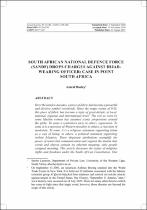| dc.contributor.author | Booley, Ashraf | |
| dc.date.accessioned | 2022-05-05T11:27:57Z | |
| dc.date.available | 2022-05-05T11:27:57Z | |
| dc.date.issued | 2021 | |
| dc.identifier.citation | Booley, Ashraf ‘South African National Defence Force (SANDF) drops charges against hijab-wearing officer: Case in point South Africa’ Jurnal Syariah 29:2 (2021) pp. 195–206 | en_US |
| dc.identifier.issn | 0127-1237 | |
| dc.identifier.uri | https://doi.org/10.22452/js.vol29no2.2 | |
| dc.identifier.uri | http://hdl.handle.net/10566/7358 | |
| dc.description.abstract | Over the last few decades, a piece of fabric has become a powerful and divisive symbol worldwide. Since the tragic events of 9/11, this piece of fabric has become a topic of great debate, at local, national, regional and international level. The veil as worn by some Muslim women has assumed iconic proportions around the globe. To some it symbolizes piety to others, oppression. To some it is a rejection of Western morality to others, a rejection of modernity. To some, it is a religious statement supporting Islam as a way of living; to others, a political statement supporting violent Islamists. These disparate attributions exemplify the power of nonverbal communication and support the maxim that words and objects contain no inherent meaning; only people assigned meaning. This article discusses the status of religious rights and freedoms under the South African Constitution. | en_US |
| dc.language.iso | en | en_US |
| dc.publisher | Academy of Islamic Studies, University of Malaya | en_US |
| dc.subject | Religion | en_US |
| dc.subject | Freedom | en_US |
| dc.subject | Legal pluralism | en_US |
| dc.subject | Equality | en_US |
| dc.subject | Culture | en_US |
| dc.title | South African National Defence Force (SANDF) drops charges against hijab-wearing officer: Case in point South Africa | en_US |
| dc.type | Article | en_US |

